Regionale 22
Pictorial Spaces
28.11.2021 —
2.1.2022
An annual group exhibition developed in the context of Regionale, a cross-border cooperation of 19 institutions in Germany, France and Switzerland focusing on local contemporary art production in the three-country region around Basel.
Can painting be a museum, light in space, traces of nature? What role do digital media play in a genre that has — until now — primarily been created through an analog process? How can painting be conceived of differently when it is hardly the classical medium any more, nor are the instruments that are used?
Thirteen artists from the trinational region are working within an artistic genre that has long needed to be broken open — especially conceptually. Painting today, then, is so much more than its recognized definition. The eclectic, large-scale and generally expansive works at the Kunsthaus Baselland bear witness to this.
Through an international perspective on the subject, through artists who work in Switzerland, Germany, and France while representing a lived internationality in the region at the same time, the exhibition provides a multifaceted insight into a persistently vibrant and current medium.
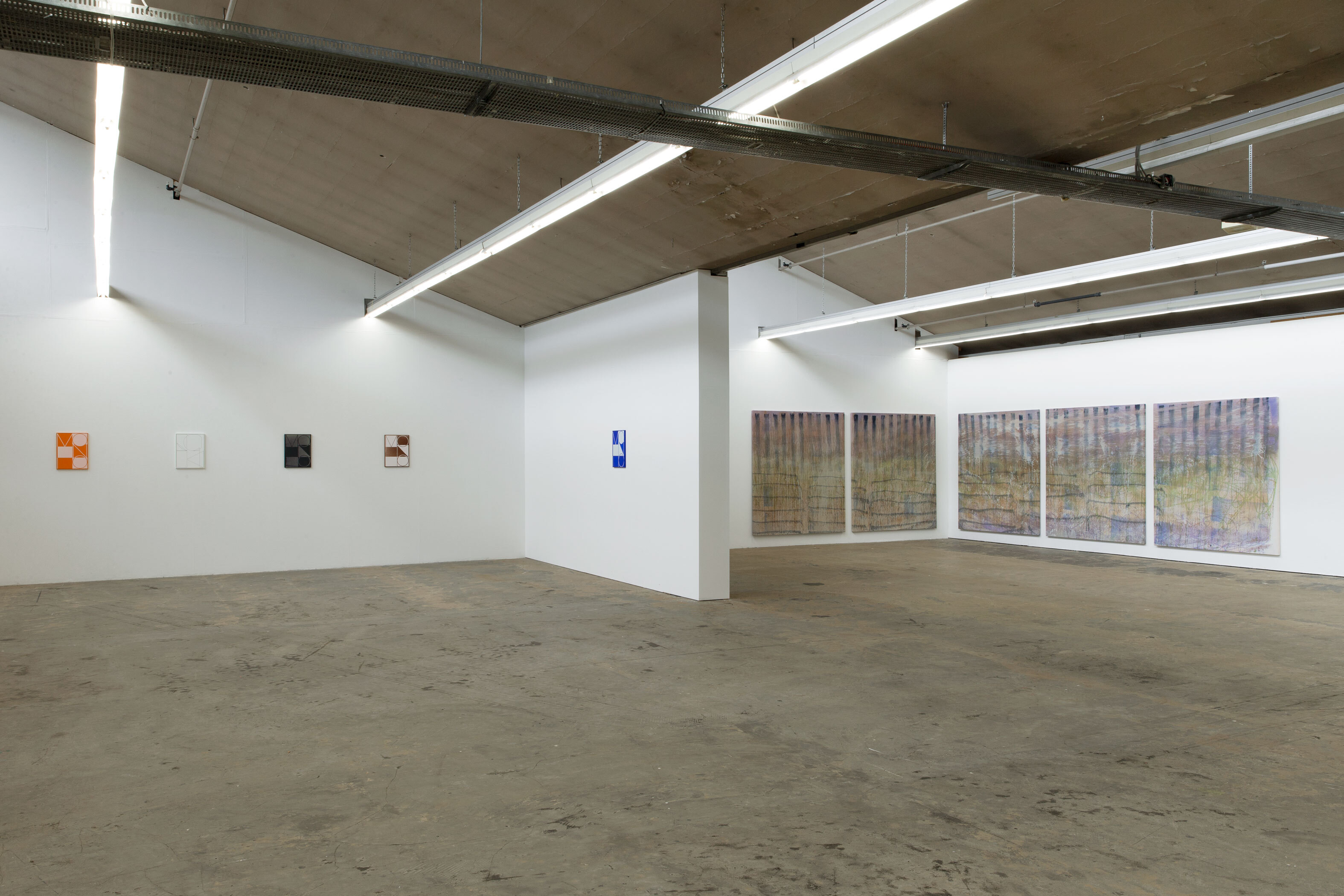
Five small-format panel paintings
are hanging on a white wall at the
Kunsthaus Baselland. Differently
colored surfaces with abstract forms
can be discerned. Orange, brown,
blue and white, as well as black and
silver stand out and invite visitors to
explore them in more detail. At first
glance, they are only differentiated
by color (except for MONO painting
mirrored outlines). But if you take a
closer look, you will not only see a
play of monochromatic color fields,
but also different compositions and
materialities resulting from it.
In his MONO paintings series,
Tim Bohlender (*1987, Kandel, DE) explores the potential of
this particular genre by working on
the same subject time and again.
Instead of using a brush, the artist
applies paint with a roller or lets
either ink or brown pigment mixed
with a binding agent run across
the canvas. The paintings owe
their resulting surface structure
primarily to the process-based
manufacturing of their support: the
canvases, which are mounted onto
cardboard, are primed with many
layers and partially painted over
so that their original structure can
disappear. Their color fields are
painted in different ways. This allows
the composition to be completely
rearranged and typographic details
to be placed either in the foreground
or background, as well as the
alternation of smooth and shiny
surfaces, which eventually make
the visible and exciting differences
between individual images
discernible.
As precise and clear as Tim
Bohlender’s small-format works
may appear at first glance, after
prolonged examination they still
offer plenty of room for the viewer’s
individual interpretations. Ultimately,
by employing reduced means, the
artist wants to bring us closer to
objects that are simple and familiar,
encouraging us to think about what
(abstract) painting can be in the
present day (PH).
The kind of art that you can take
with you and exhibit anywhere in
the world, no matter where you
come from or where you are going,
irrespective of space and time. This
is how Mariejon de Jong-Buijs (*1970, Waalwijk, NL)—
who was born in the Netherlands,
lived and worked for a long time
in the US and is currently based in Basel—describes her paintings.
At the Kunsthaus Baselland, she is presenting the outdoor project
Hopewell Woods as part of
Regionale 22. Executed in 2020 in
the eponymous New Jersey location
in the US, the project consists of five large-format paintings and a
photograph showing the artist during
the creation of this group of works,
thus signalling the importance of the
creative process for her practice.
In line with Mariejon de Jong-Buijs’
action art, the five equally sized
cotton sheets are part of a broader performance. They were stretched
between three trees as a single,
15-meter-long piece of fabric, to
which the artist added a personal
mark every day for a week during
the pandemic. She experimented
with different tools, colors, and
motions. The result: paint drips and
runny circles, as well as strokes
revealing traces of particular tools.
“My intention is to let the viewer
wonder what they’re looking at and
what remains hidden,” de Jong-Buijs
says.
At the Kunsthaus Baselland, the
fabric pieces hang on the wall like
pictures. The artist folds her works
in one place to unfold them again in
another and present them hanging,
stacked, or in some other way—a
process that is analogous to her life
on the road. In so doing, she also
plays with a centuries-old genre,
asking: what is it that painting can
actually be? (PH)
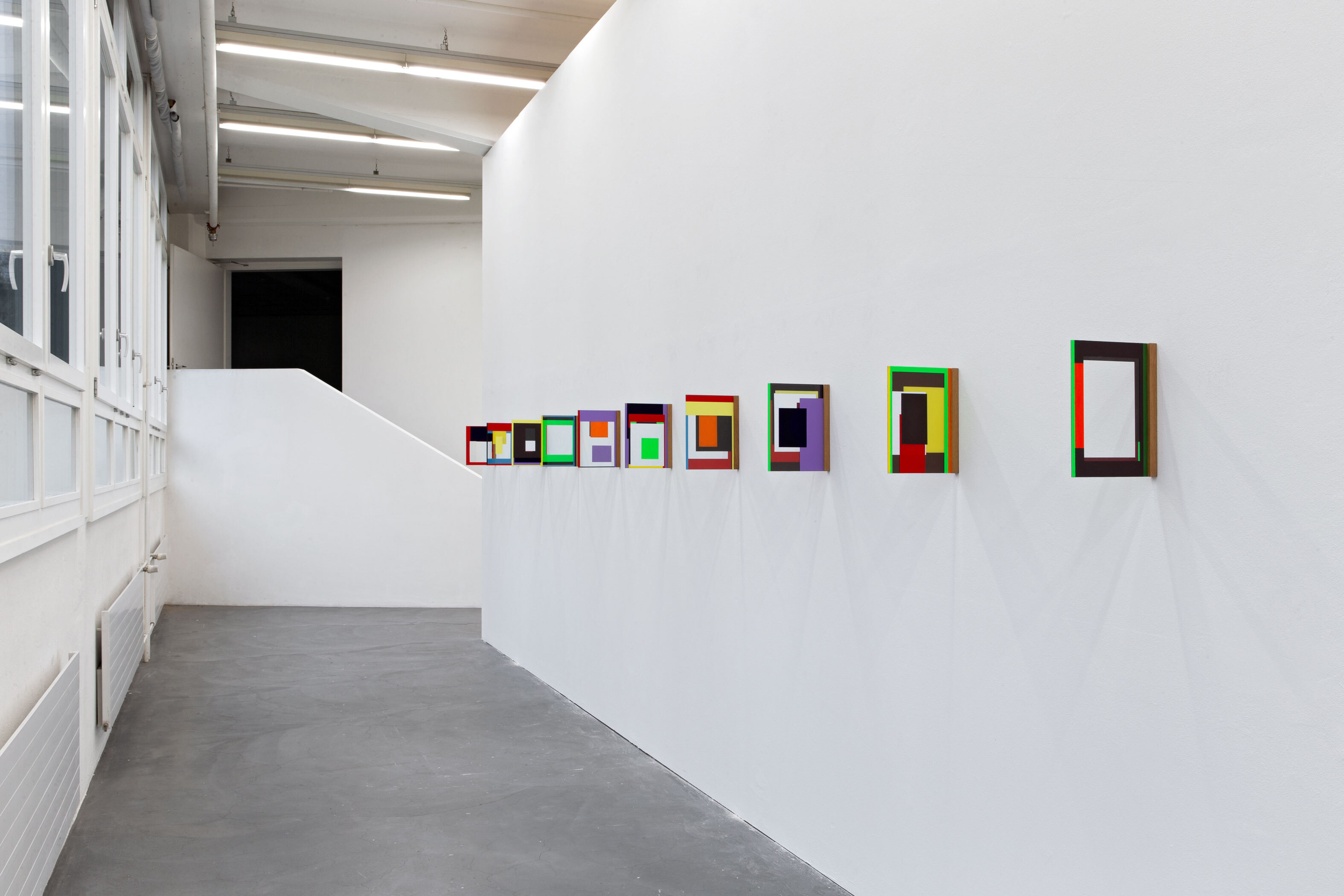
Anja Braun’s painting practice is primarily interested in seeing,
perceiving, and experiencing—and
this is what fascinates her about it. As an artist who combines
performance and painting, she
always integrates the viewer into her
work. This concern for an art that
operates with a counterpart is also
apparent in the series shown at the
Kunsthaus Baselland. The Windows,
painted with pigments on glass, are
fascinating in many ways and reveal
what painting can be on different
levels.
The Windows fit wonderfully into the
space opposite the large window
front, enriching it with their play of
light, color, reflection, and mirroring.
They invite you to approach them,
walk around them, look into the
room and the other Windows
through their transparent glass, and see how the paint on the glass
incorporates reflected subjects—
including yourself—and makes them
part of the work. Through this shift in
perspective, the changeable nature
of painting as it engages with the
surrounding space can be distinctly
experienced. No matter from which
angle we look at the Windows, new
experiences are always revealed to
us. If we look straight at the wall, we
perceive the colored glass only as a
stroke, a layer of paint merely hinted
at. It is a view that is only granted
to us due to our detachment from
the surface. Looking at the painted
surface, we witness the individual
pigments’ tactile and material
qualities; from the other side, we are
surprised by the luminosity that the
glass unleashes from the pigments.
The idea of the window is also taken up in the composition. Here,
however, it has a different source
than the material’s transparency. The
artist has been making drawings of
open, overlapping windows on her
laptop screen for some time, always
transferring the combinations of
two sketches onto glass. Through
this gesture of transforming a digital
source into an analog, painterly
visual language, Braun reveals yet
another dimension of what painting
is capable of being (MS).

At times dominant or timid, other
times wild or gentle, bold or languid,
colorful brushstrokes run in diverse
ways across Annegret Eisele’s (*1980, Filderstadt, DE) works
on paper, some of which are up to
one meter in length. In the foyer of the Kunsthaus Baselland, the
individual works combine to form a large installation that unfolds a
multi-layered narrative world. Their
colors, shapes, and lines capture the
artist’s impressions and sensations,
forming a swarm of snapshots. In
her painting, Eisele finds a form of
expression—a formal language—in
the way she envisions a parallel
world out of color, light, and sound
structures. Through an abundance
of color in its innumerable nuances,
she attempts to create a sound space; color also becomes an
invitation for the viewer to plunge
into this abstracted pictorial world’s elements—or to completely
disappear inside them. This
abundance of color is enhanced by
the invitation to slip into the picture
offered by the works’ concise, poetic
titles, which attempt to bridge the
gap between image, painting, and
language.
Prompted by an interest in the poetry
and abstraction of everyday life,
these works show reminiscences of
the inspiration behind them. The artist
is particularly fascinated by unusual
sights of everyday things—whether
these are symbols and signals that
have become barely recognizable or
legible as such or repairs to house
facades that become visible through
a slightly different shade of color. She
is equally inspired by simple technical
constructions, as well as gazing into
the distance, natural phenomena,
and light. Focusing on the here and
now has always played a vital role
for Annegret Eisele. In this way, time
becomes expanded and intensified,
allowing her to slip into a different
reality (MS).
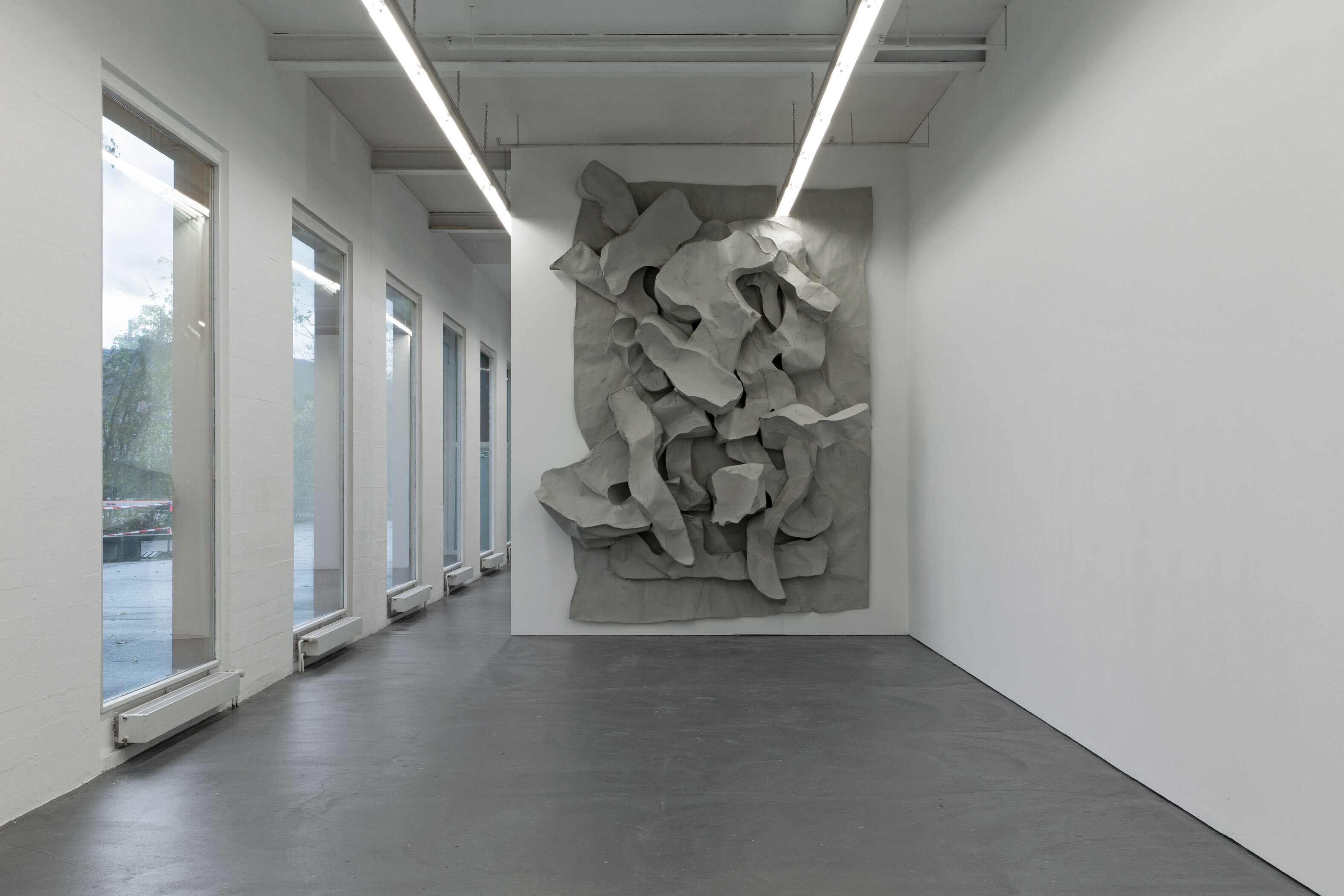
We can’t help but be surprised by the choice of medium and its
effect in particular. Over and over
again. Is it metal, cut and welded, or stone that hangs heavily on the
wall? Or is it – and can it actually be – paper? But Simone Holliger (*1986, Aarau, CH) is not concerned with provoking
confusion. Rather, she chooses a
specific material in order to be able
to respond as best as possible to
the process and to the freedom
inherent in making – usually on-site
and on the spot. Bodies that stand
freely in space or reliefs like the one
in the Kunsthaus are built layer-by-
layer over a number of days. They
grow into and with the space around
them. The artist, who works in Basel,
responds to space in the way she
considers and builds it—its texture,
tonal value, smells, temperatures
and people. Decisions about color
schemes emerge at the end as a
logical outcome of this process.
In the actual room, the dimensions
of the spatial element alone make it
a relevant counterpart, opening up
here and there to reveal glimpses of the work, as well as how it was
made. This element is sometimes
matt, sometimes shiny, at other
times soft or sharp-edged. However,
it never seems to fully disclose its
secret, because the fascination for what spreads out in front of you remains even after prolonged
contemplation —and the same goes
for the feeling of surprise (IG).
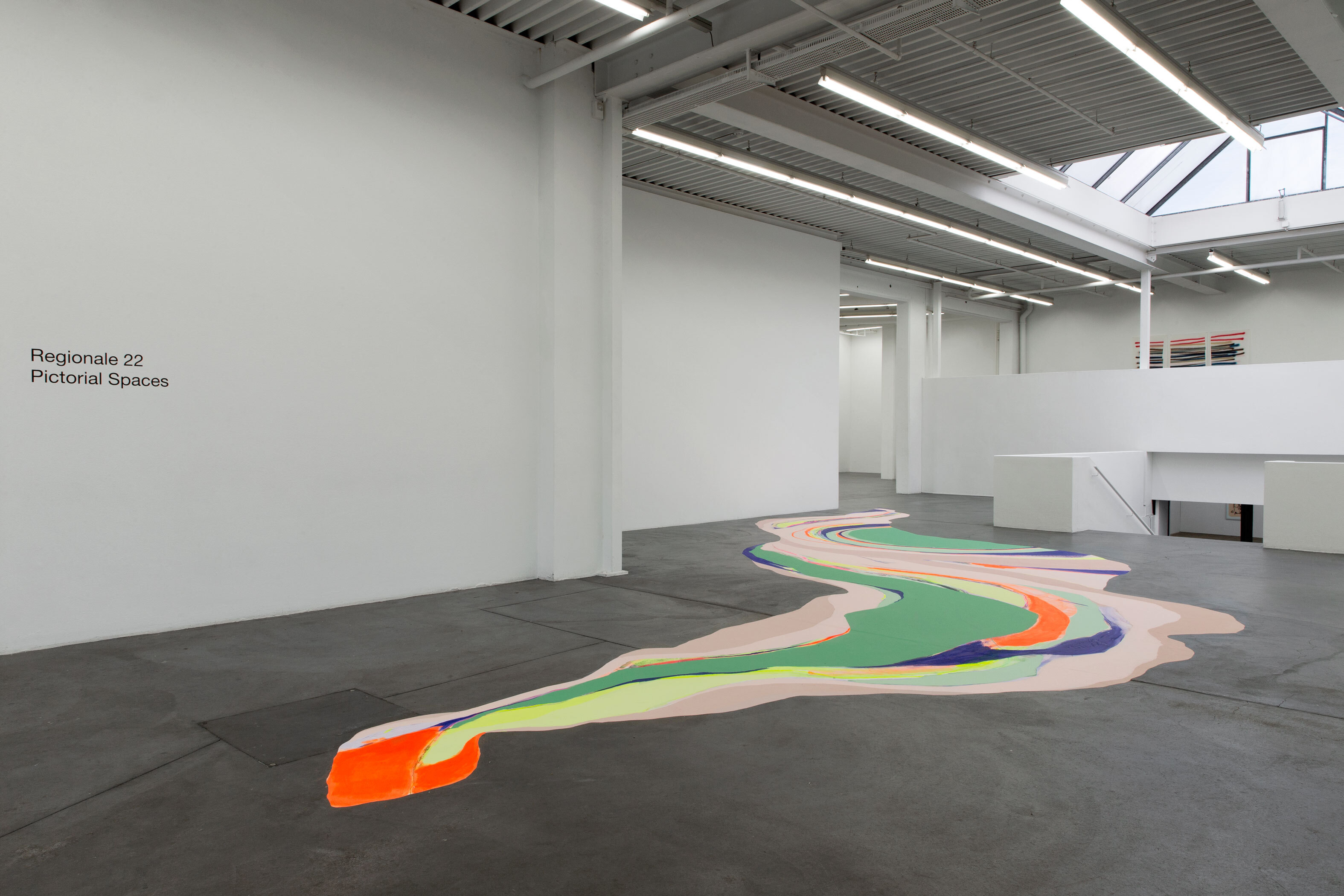
Sonja Lippuner began her artistic
career as a sculptor. Gradually, her focus shifted towards the
medium of drawing, which she
uses to test the boundaries of
installation. By drawing on pieces
of cloth that she sets in space, she
creates a fluid transition from two-
dimensional drawings to installation
environments. The creative process itself is very
important to the artist. She attributes
a major role to taking a step back
from the work and looking at the
whole from a distance, constantly
repositioning oneself, asking: Where
do I stand? What dimensions am I
working with?
These processes—zooming in and
out, always changing positions to adopt new perspectives—are
reflected in Sonja Lippuner’s work
Zunge at Kunsthaus Baselland. The
work resembles a map. Circles and
lines sprawl across the foyer, guiding
visitors through the start of the
exhibition. It is a map of an unknown
landscape. But the viewer does not walk through it, rather around it: a map according to which one
constantly repositions oneself, and
which determines to a certain extent how visitors move across the foyer
and into the exhibition. New views
are discovered, new perspectives.
And yet the work can never really be
grasped as a whole. Due to its size
and position on the floor, the parts
that are farthest from us remain
blurred areas on the periphery of our
perception (MG).
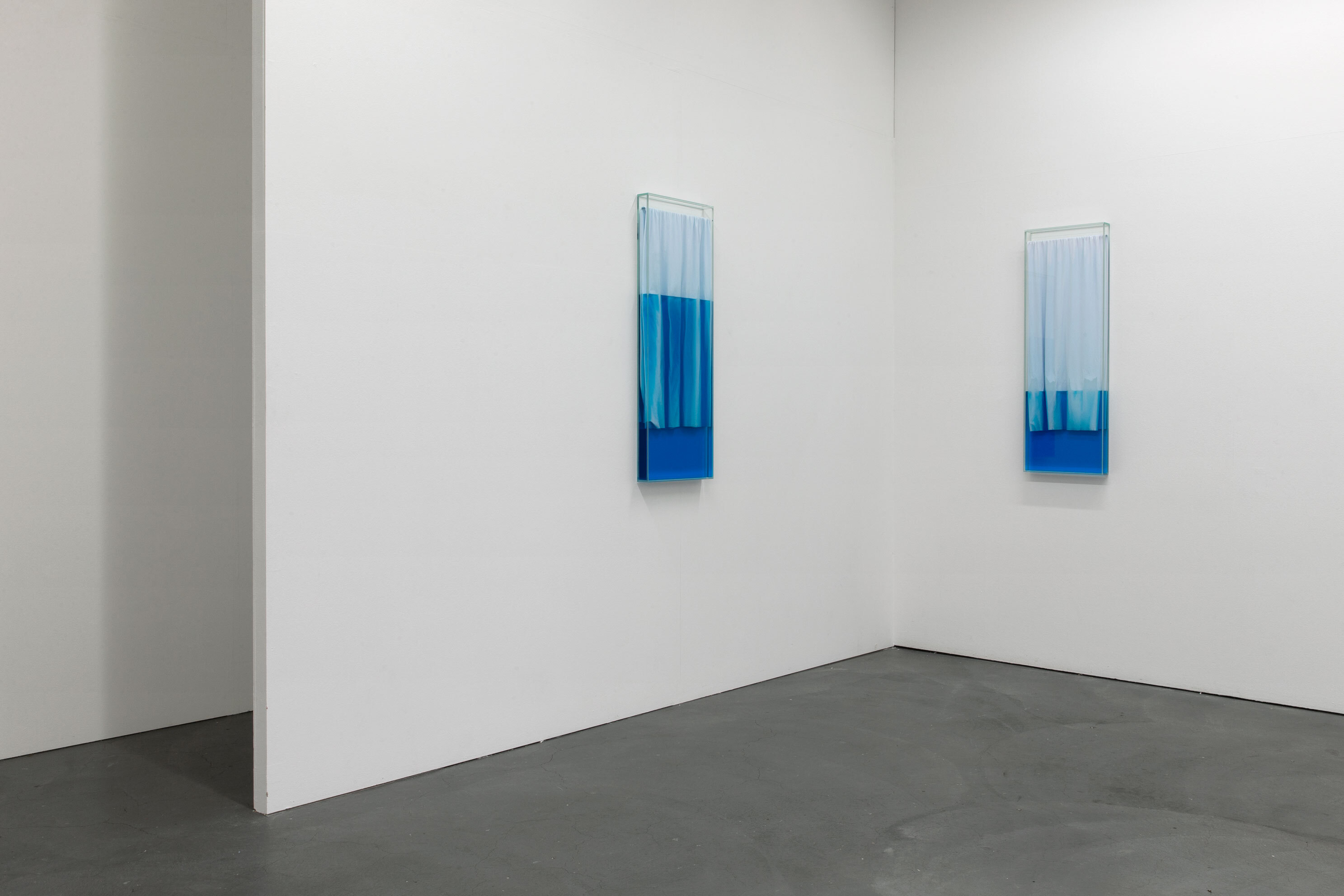
White microfiber cloths used for
cleaning surfaces; the blue liquid is
window cleaner. In narrow display
cabinets, the liquid can be seen at
different heights. The white cloths
slowly soak up the moisture. Time
is running: a process that the blue
color makes visible.
Vincent Lo Brutto’s (*1995, Mulhouse, FR) ’s installations
oscillate between the visible and the invisible, presentation and
representation. Conservation is
indispensable for the survival of art, yet it is kept in the background,
never actually being addressed as a subject. Cleaning utensils keep
sculptures clean, becoming a part of
them. Following a thorough study of
conservation and display furniture,
the artist has turned them into the
main subject of his works. They take
their place on pedestals as works in
their own right. The functional object
becomes the subject, the invisible
becomes visible.
Both works’ titles, Ninfa (I) and
Ninfa (II), evoke associations with
nymphs, the nature deities from
Greek and Roman mythology. They live virtually endlessly while
remaining eternally young. Time,
whose course is so evident in the
two sculptures, is irrelevant to
nymphs. The white fabric in the
showcases recalls their light white
robes, oscillating between clothing
and nudity. In classical sculpture,
the ability to carve folds and the
flow of fabric in stone is a testament
to technical virtuosity. The drapery
motif runs through representations
from all periods of art history. The
fabrics in Lo Brutto’s work are a
tribute to this immortal figure of
drapery, which art historians and
philosophers, such as Aby Warburg
and Georges Didi-Huberman, have
called “Ninfa.” (MG)
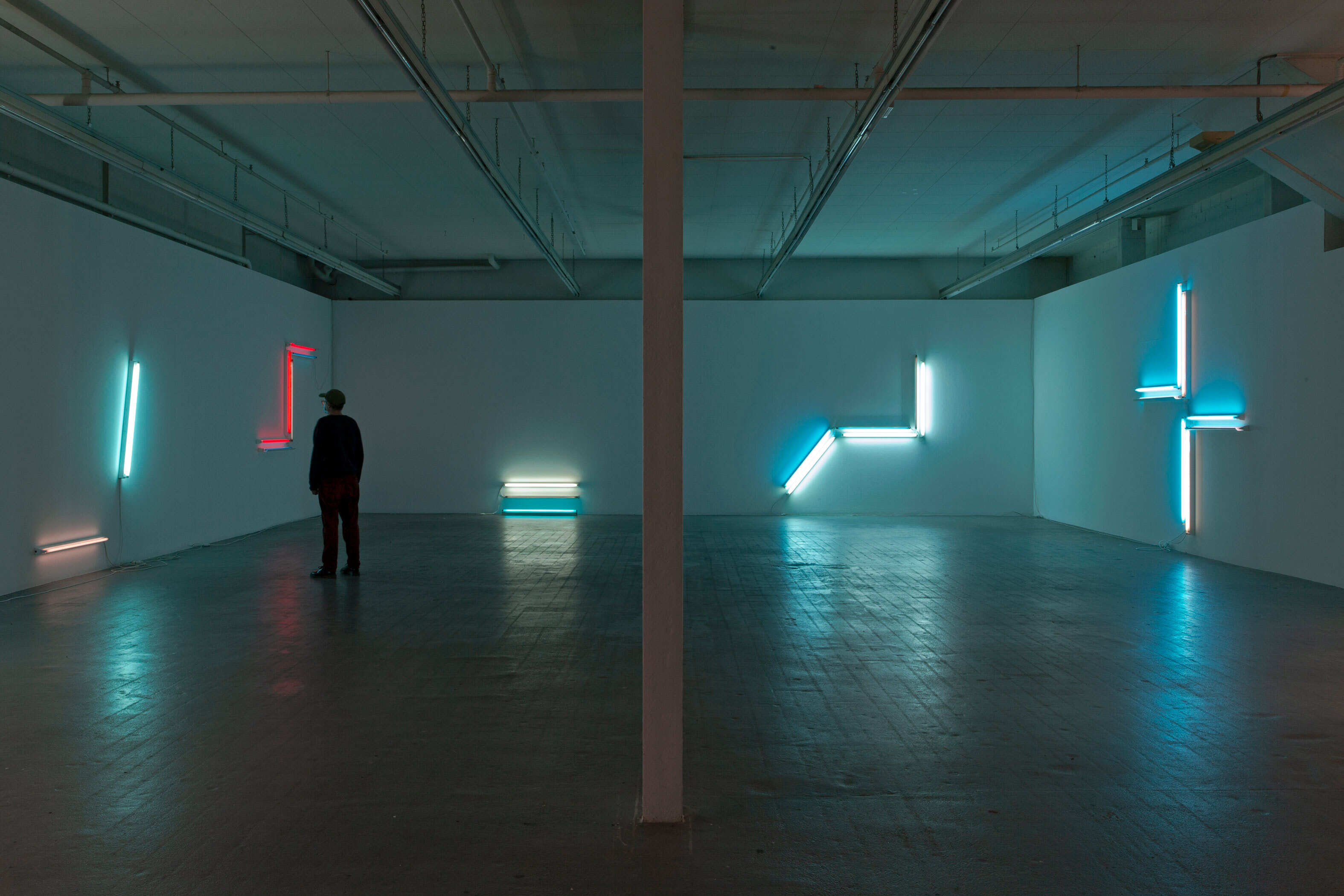
How do biography, gender, and
the handling of estates impact the way women artists from 20th
century are seen today? This is
one of the central questions that
Céline Manz (*1981, Zurich, CH)
explores in her work
using strategies of appropriation
and recontextualization. The work
fold; Aubette 63 is a series of neon
sculptures dedicated to the artist
Sophie Taeuber, who was born
in 1889. It was first conceived for
Manz’s solo exhibition 9 espaces
distincts at Kunsthaus Langenthal in
2020 and has now been expanded
to include new elements for
Regionale 22.
In 1928, Sophie Taeuber finished her work as site manager on the
Aubette leisure center in Strasbourg,
for which she collaborated with
Hans Arp and Theo van Doesburg. In a room-spanning installation at Kunsthaus Baselland, Manz
references the center‘s foyer bar, a space designed by Taeuber. Its
initial design, Aubette 63, could not
be executed due to a veto by Van
Doesburg (“too colorful”). Although
it was a collaborative project, van
Doesburg repeatedly claimed
sole authorship of the Aubette.
Manz, who has studied Taeuber’s
plans and architectural drawings,
counters this effort with a gesture of
posthumous reclamation. The artist
now transposes Taeuber’s synthesis
of architecture and painting
into her own formal language,
extracting colors and forms from the
architectural drawing Aubette 63 and
setting them in space as luminous
neon sculptures (IT).

We could maybe start like this:
Camillo Paravicini (*1987, Poschiavo, CH) is against any
form of assertion. Assertions like:
This is painting. This isn’t. One
thing is more important than the
other. This is worth more than that. And so on. He seems to use
the artistic act specifically to find
out something and counter these
assertions. Small drawings created
in a matter of seconds are the
starting point for the new series
produced at the Kunsthaus. Are
they interesting enough to stand
the test of time? In order to answer
this question, Paravicini resorts to a complex approach. The drawings
are enlarged and, using a kind of
painting behind glass technique, are transformed into a painting. Its
whole appearance changes from a
quick, small-format gesture into that
of a seemingly flawless, high-gloss
work. You could call it a form of
improvement—or perhaps a kind of
assertion?
It is entirely fitting that Paravicini is
showing newly produced, previously
unseen photographs from his archive
alongside these now painterly,
large-format, “refined” drawings.
And it is no coincidence that
Paravicini chose the title Ferien in
Düsseldorf (Holidays in Düsseldorf).
It alludes to the Düsseldorf-based
photography class led by Hilla and
Bernd Becher and, more specifically,
their students. Prominent figures
such as Thomas Ruff, Andreas
Gursky, and Candida Höfer have
become paragons of high-end
artistic photography with their large-
format, stylized images—most of
which were taken in the Ruhr region.
Paravicini now consciously turns
this perception of values around. He
transposes precise photographic
compositions into a small format
and thus subordinates them in size
to the quickly sketched drawings.
In so doing, he keeps his approach
both solemn and humorous. Doesn’t
a particular photograph also have a
painterly quality more than anything
else? Does this attribution of genre
still make sense today? Or would
we possibly give it a different value
if the format were to change? High
and low are often found in close
proximity—in life as in art (IG).
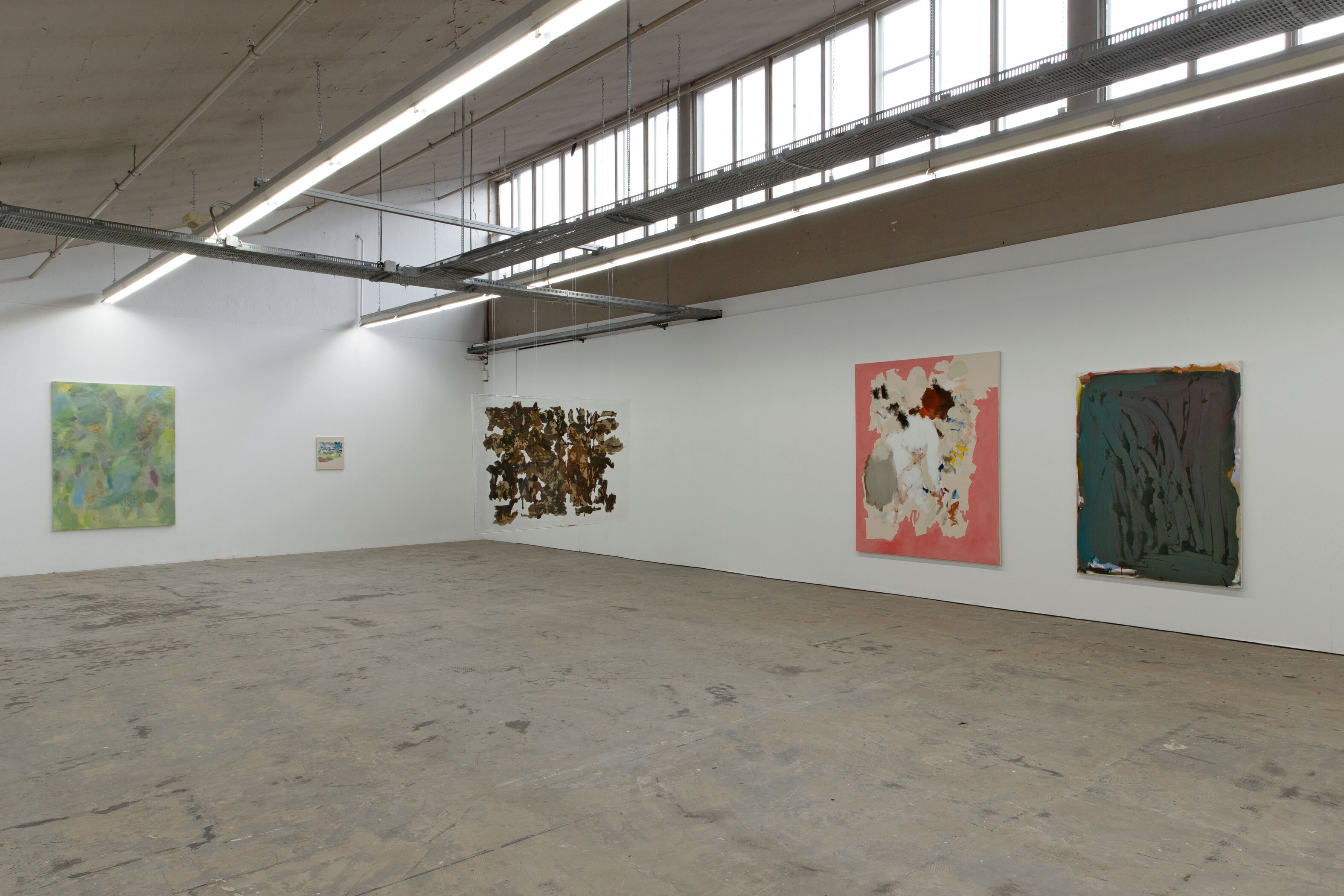
David Richter’s (*1988, Basel, CH) paintings explore
liminal moments. They oscillate
between allusion and reflection,
front and rear view, as well as form
and negative space. With distant
references to works by Etel Adnan,
Nicolas Poussin, Tom Thomson, and Joaquín Sorolla, the artist
investigates pictorial systems, which he places in a contemporary
discourse using a monotype printing
technique. The image, transferred
with a thin plastic sheet, becomes a
membrane that not only interweaves
spaces, but also spreads out
through them. The usage of both
blank spaces and pictorial inversion
suggests the paint to have seeped
through the linen. This provokes a
change in the viewers’ position: they
are looking at the work’s reverse—or
an idea of it.
Employing strategies of
appropriation, as well as affirmation
and refusal of the painterly gesture,
Richter creates new pictorial spaces
by gathering works from the last
three years that explore key aspects
of this traditional medium (IT).
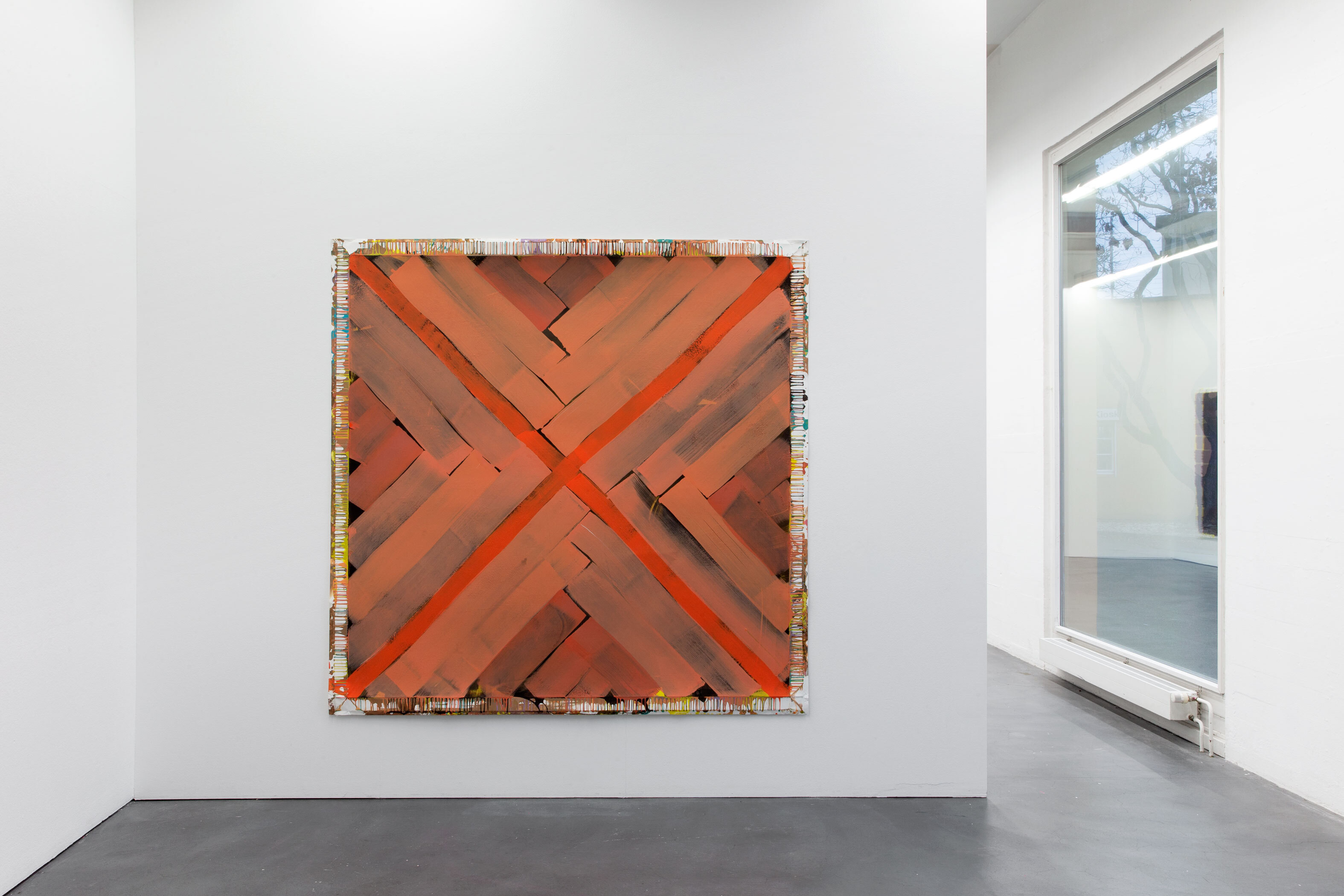
To choose a square format means
not to determine a direction—neither
to the right nor to the left, as would
be the case with a rectangular
shape. Rather, its strength comes
from the center. In Maja Rieder’s
(*1979, Solothurn, CH)
work, boundaries between painting
and drawing also give way to the
fundamental openness of her artistic
process. I remember pictures taken
in her studio: large sheets of paper,
only partially unrolled, almost
covered the floor in its entirety.
The artist, moving across the room
hunched over, held wide brushes,
some of which she had made
herself. All the generosity that her
oversized, painterly drawings exude
comes from her masterful gestures:
a swift sweeping motion, a precisely
executed brushstroke guided by the
dimensions of the body, an intuitive
choice of color, the skillful steering
of paint or tonal values across the
pictorial support until it runs out. At
times, her papers are stretched wet
on a chassis and later removed from
it. The act of painting is revealed on
the works’ margins, which show the
start of lines, X-shaped crosses, or
hatching. It is these margins that,
at the moment of installation, seem
to connect with lines in space like a
delicate structure (IG).
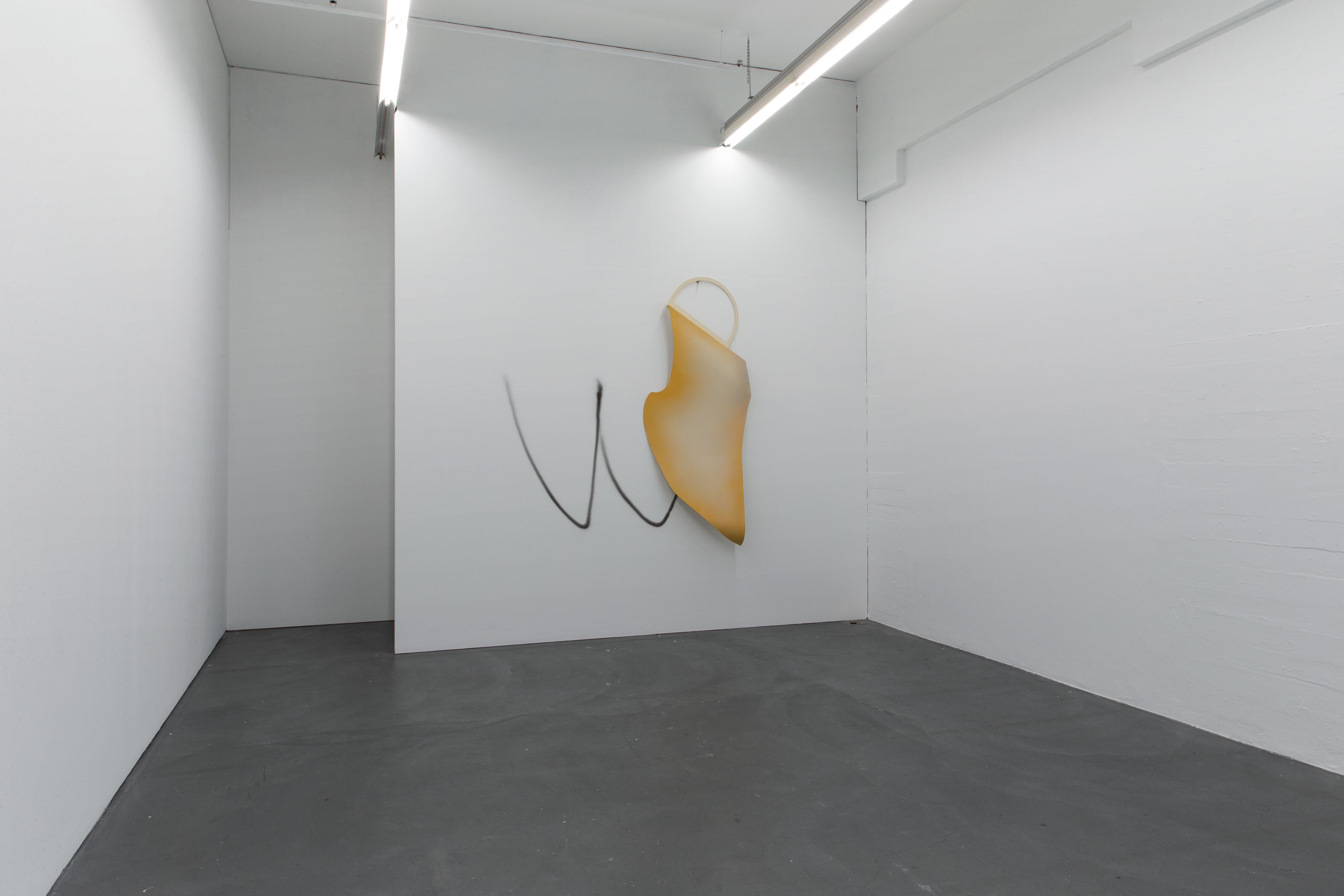
Susanne Schwieter’s (*1971, Basel, CH) sculptural
work from her series tongues leaps
from the wall into space, where it encounters visitors with a calm
balance of color, line, and white
space. The shape of the powder-
coated aluminum surface suggests
the tongue’s position during the act of speaking. Lines sprayed on
the wall emphasize the circulatory
process of frozen movement, fading into infinity under the metal’s
shadow. The artist describes her
abstract works as “evolutionary
forms.” This is a concept that
explores the translation of language
into signs via a process-based
approach, solidifying ephemeral
images as a result.
The work’s title, Shh, also inquires
into language’s significance for
personal identity and the perceptual
and thought structures that come
with it. At the same time, we could see it as a description of the
moment when language’s limitations
become apparent, and color and
form show a way out. (IT)
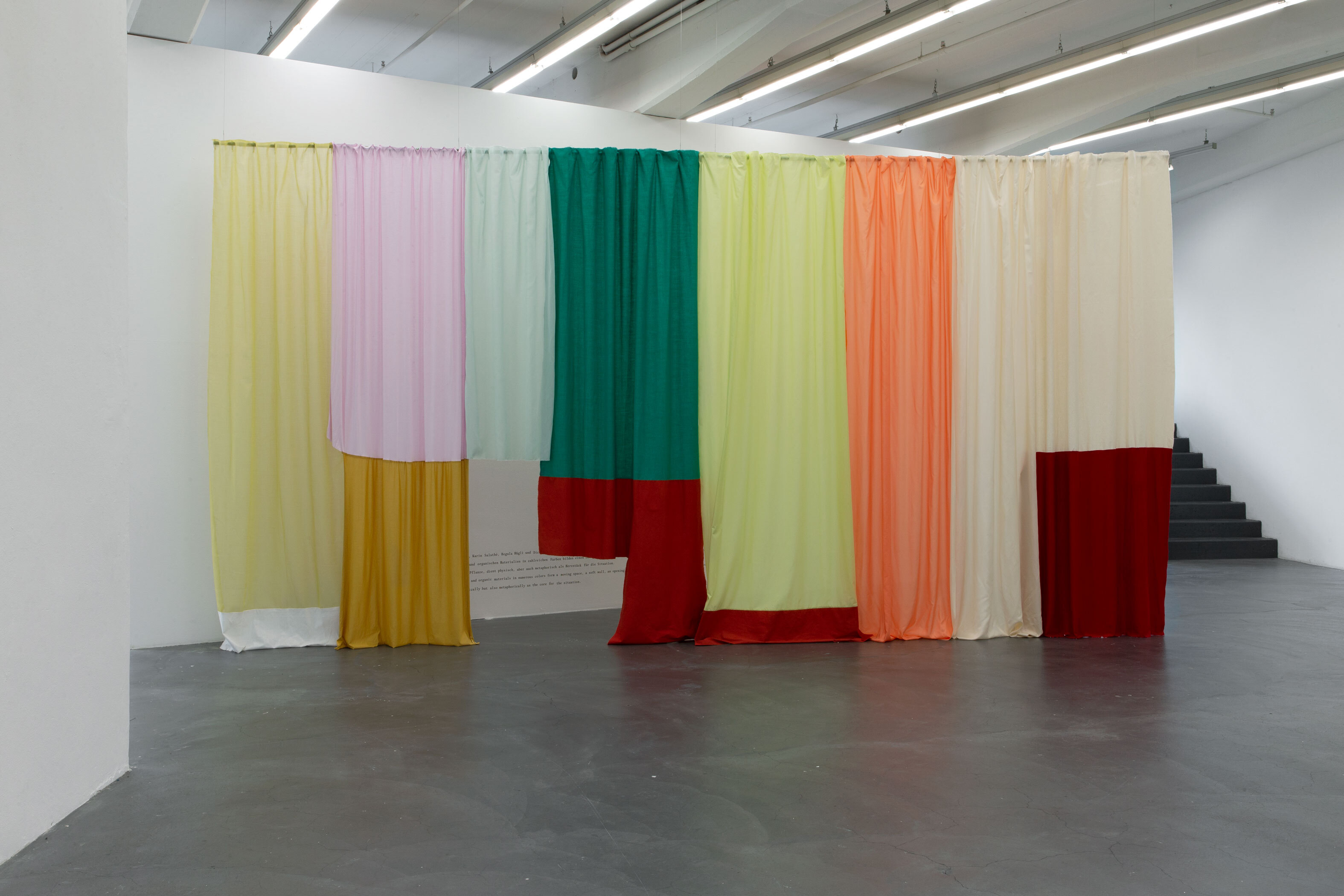
Kathrin Siegrist (*1984, Basel, CH) is an artist who
draws most of her inspiration from
collaborative and transdisciplinary
practices. Exchange, discursive
elements, and communication are of
vital importance to her artistic work
and allow her to create a dialogue
between the individual and the
collective through painting.
The curtain exhibited at the
Kunsthaus is also the result of a collaboration between several agents. Its installation
during Regionale 22 and the
accompanying text are meant to act
as the remnant or documentation
of the Gartenzentrum, where clear
definitions of what constitutes an
artwork no longer apply.
During lockdown at the beginning of
the year, when cultural institutions
had to close their doors due to the
pandemic but garden centers were
not affected by these restrictions,
Siegrist transformed her studio
precisely into the latter. Cultural
exchange persisted on a small
scale in this space, whereas it was
no longer possible in traditional
institutions. In this context, the
curtain was conceived as a site-
specific work: as a display, a spatial
object that is functional, decorative,
and performative—a painting that
creates a (social) space. It is soft
and mobile; the curtains’ fabric is
reminiscent of traditional pictorial
supports. The organic and synthetic
fabrics, which originally occupied
the space from floor to ceiling,
convey warmth and security through
their materiality and colorful palette.
They invite us to approach the work
so as to experience textile painting
on different levels (MS).